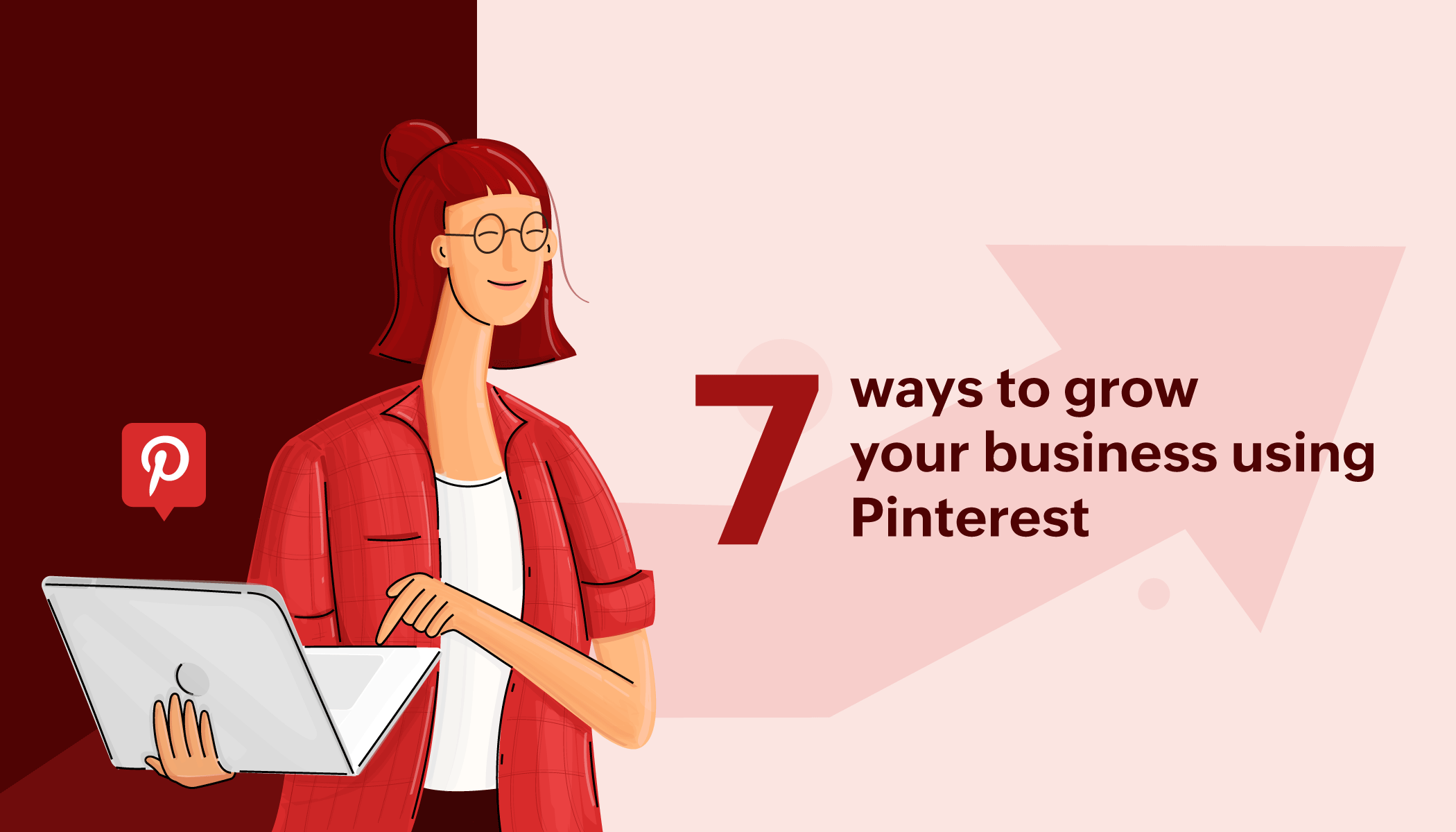Top 7 Inbound Marketing Techniques for Effective Demand Generation
- Last Updated : August 17, 2023
- 5.6K Views
- 10 Min Read
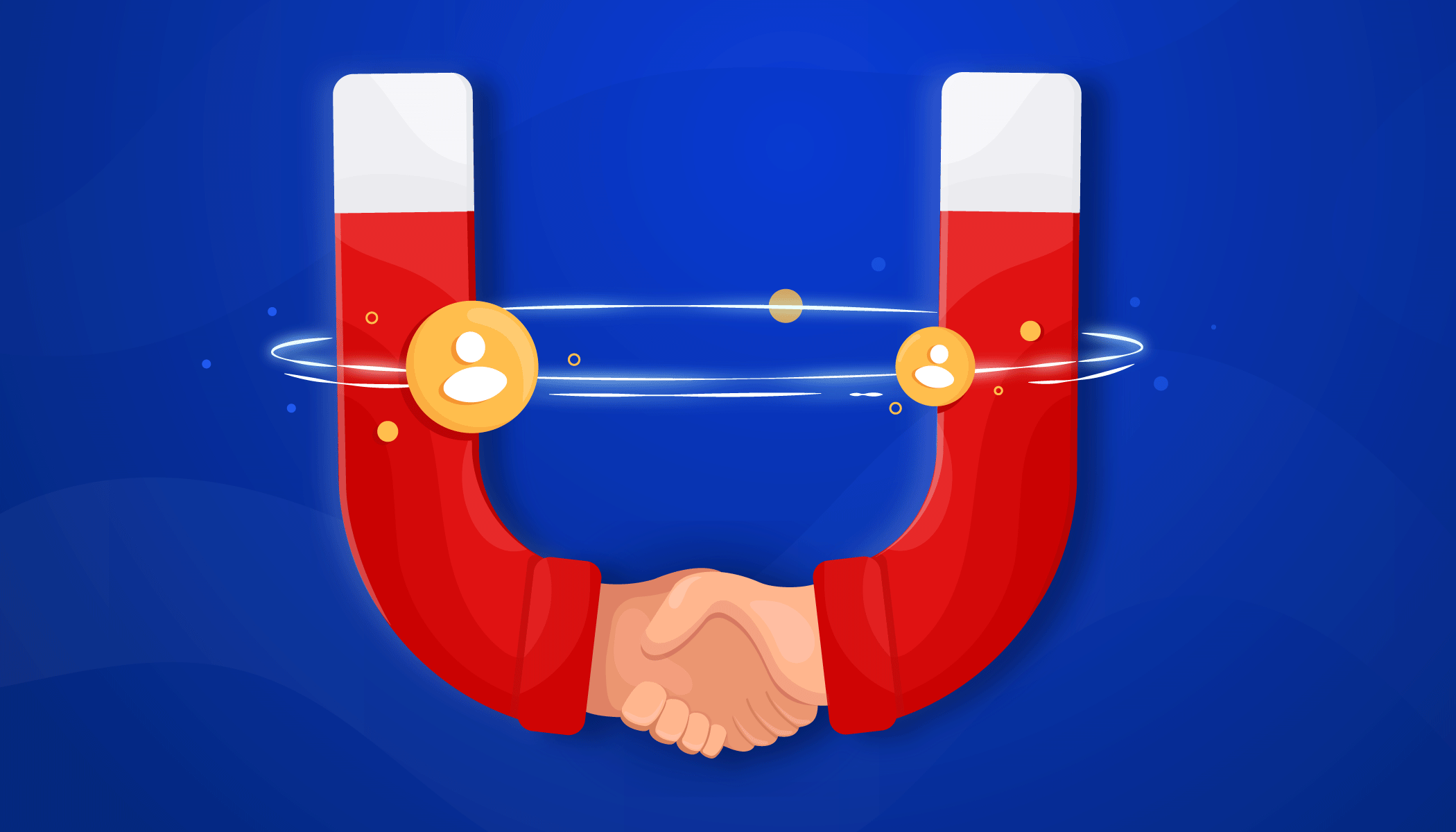
This is the guest post from Gaetano DiNardi, the Director of Growth Marketing at Nextiva and has a track record of success working with brands like Major League Baseball, Pipedrive, Sales Hacker and Outreach.io. Outside of marketing, Gaetano is an accomplished music producer and songwriter - he’s worked with major artists like Fat Joe, Shaggy and loves making music to stay turbocharged.

Where does your qualified traffic come from? How do you generate your best leads?
And how can you get more of both?
If you want answers to these questions, you’re in the right place.
The core part of inbound marketing is creating content your potential customers need and look for, but businesses often forget about the importance of demand generation in it.
It’s not just about getting eyeballs on your content; it’s about building relationships with prospects and customers in the long run. Demand generation plays a huge role in showing your audience how you can help them win.
In this guide, we’re taking you through inbound marketing, demand generation, and seven techniques that make them a perfect combo (and that you can apply to your business, too).
What is inbound marketing?
Inbound marketing is a methodology of attracting customers by creating and distributing quality content they naturally look for.
It’s quite the opposite of outbound marketing, which pushes your brand’s messages to a wide audience and interrupts them.
Inbound marketing is magnetic—it pulls in people who are actively trying to research, understand, and solve a problem they’re experiencing.
These people find you through your blog posts, social media messages, customer testimonials, ebooks, videos, and other content they can follow to get closer to a solution.
Read more from Zoho:The advantages and disadvantages of inbound marketing
What is the demand generation?
Demand generation is the practice of creating demand for your company’s products or services through marketing.
It’s a holistic process; it involves every marketing function and every touchpoint the customer goes through.
Demand generation is the bridge between marketing and sales, between content and revenue. It aims to build long-term relationships and engagement with the customer.
With this sales-centric approach, you serve content to your ideal customers and present your products or services as a solution to their problems.
How does inbound marketing and demand generation work together?
Inbound marketing gets your company on the radar of a target customer. As they look around their pain points, scroll through social media, or browse YouTube, they’re looking for content that will bring them some answers.
This happens throughout their customer journey:
- Top of the funnel: early on, when they’re still researching the problem they’re facing and want to learn more about what it is and why it’s happening
- Middle of the funnel: they understand their issue better and are looking for types of solutions that could help
- Bottom of the funnel: the customer knows the type of solution they want and who provides a product/service that matches their needs best
These stages don’t always happen in this order, and not everyone comes through at the top of the funnel.
When you execute a powerful inbound strategy, potential customers will find you across all three of these because your content will answer their specific questions.
But inbound marketing alone isn’t enough. If you stop there, your potential customer will be informed… But they’ll use that knowledge to find a solution elsewhere.
Demand generation closes that gap. It shows people your product or service is the right choice for them. It converts casual visitors into qualified leads and fuels your sales team.
If your business was a brick-and-mortar store, inbound marketing would aim to get people through the door, and demand generation would focus on proving you and your products are worth their money and attention.
Without inbound marketing, you’d have an empty store; without demand generation, you’d have people walk in, look around, and walk right out. Both are essential for growth and ultimately the success of the business.
Here are seven inbound marketing methods you can use to drive demand for your business.
1. Work with influencers whose audience matches yours
Think influencer marketing only works for fashion and beauty companies (who admittedly popularized it)?
Think again. Companies ranging across industries, technologies, and business models, including B2B and B2C, have seen success with influencer marketing.
A great example is the influencer partnership between Hotjar, a heatmap tool, and Charli Marie, a graphic designer with a popular YouTube channel.
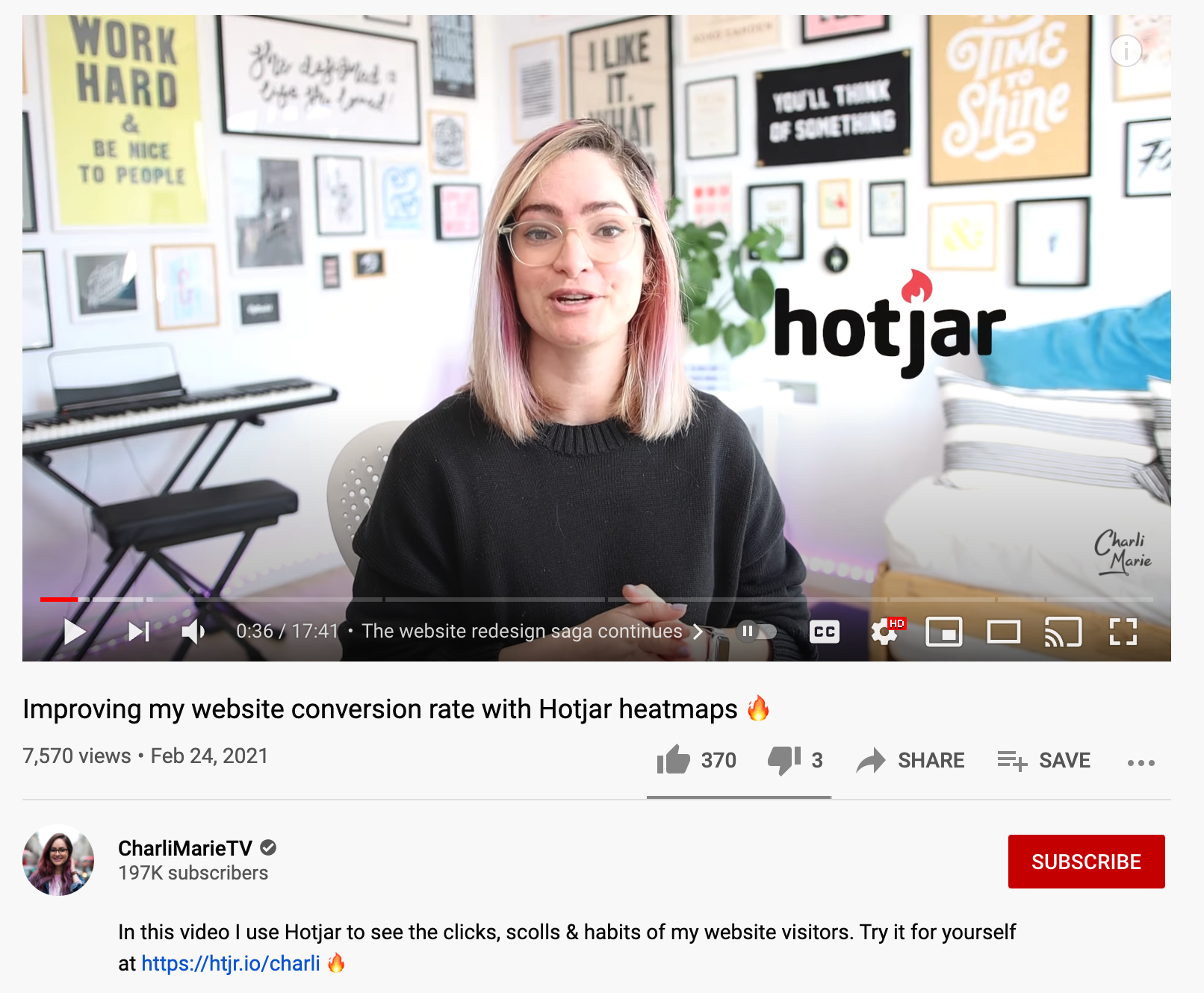
Hotjar sponsored a specific video where Charli uses heatmaps to update her personal website. Unlike the Later training, this is much more hands-on and product-focused, and it received excellent feedback from her audience—and brought new, targeted people to Hotjar.
2. Add videos to your top landing pages
Video marketing works: the State of Video Marketing report revealed that video helped directly increase sales for 78% of marketers. It also helped generate leads and improve the user's understanding of the product.
Video is a powerful asset on pages people visit when evaluating options, researching pricing, and understanding product features.
This is exactly what we do at Nextiva. One example is a blog post that compares cloud-based call centers with an on-premises setup:
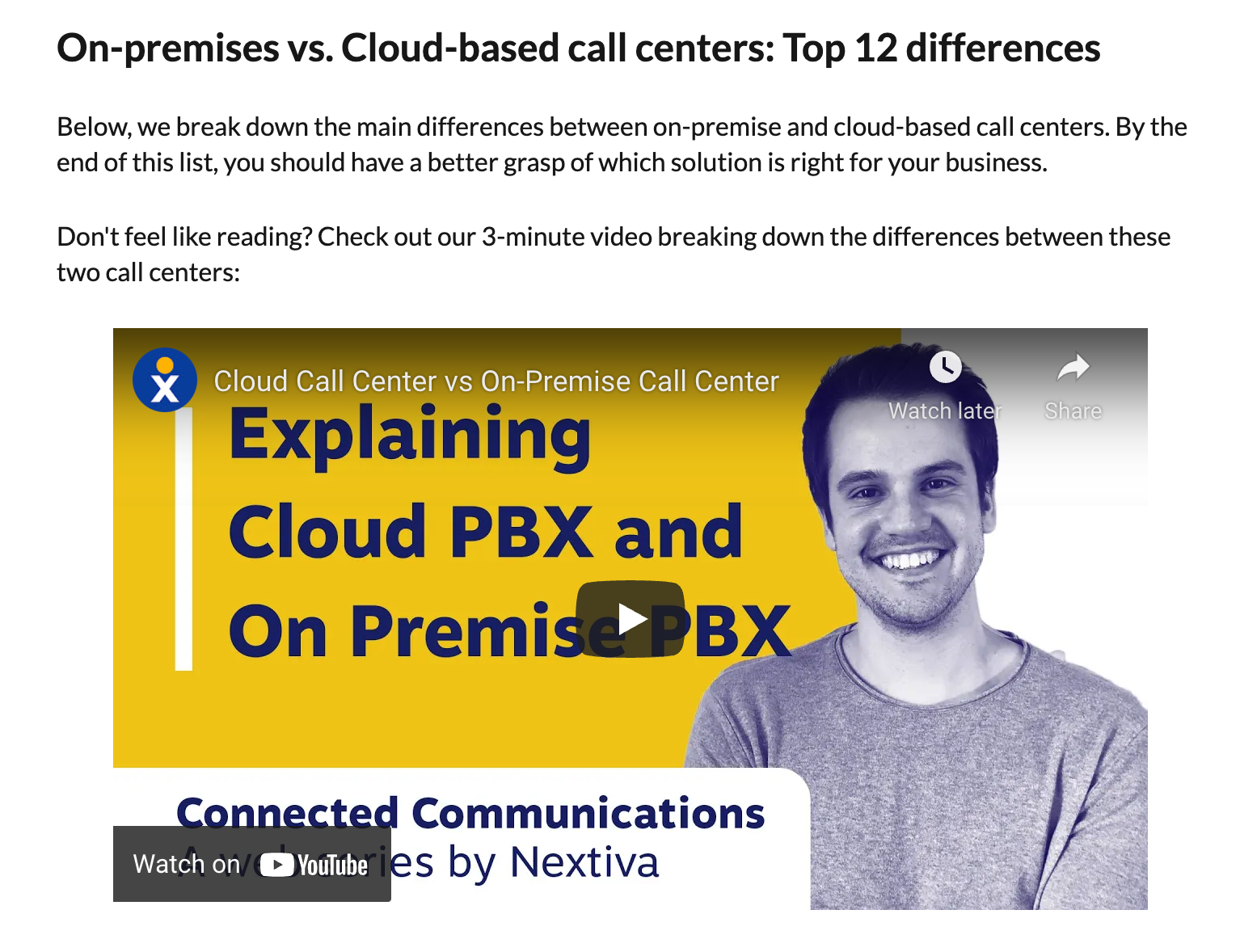
The blog post compares the cost, maintenance, scalability, and other parameters that matter to our target customer. It’s an in-depth comparison—more than 2,000 words long.
But the video tackles the most important elements in just three minutes. It also adds Nextiva’s credibility to the topic. And if someone first finds this video on YouTube, the description sends them back to this blog post, which features a call-to-action for our product at the end.
That’s the inbound call center product page, which spotlights another video. This time, the video adds an educational layer to a sales-focused page, right below our customers’ logos and above pricing:
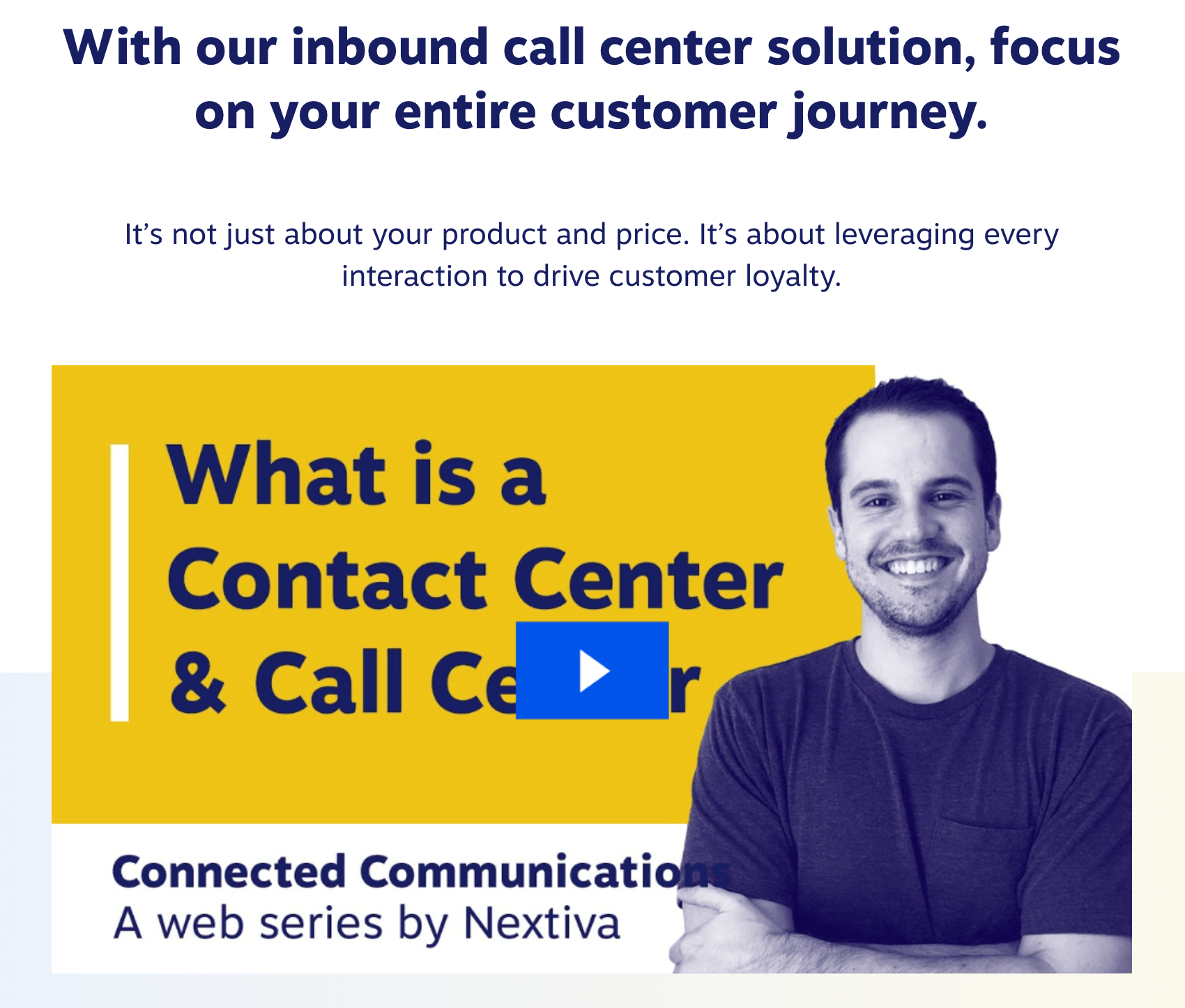
This helps Nextiva’s customers rest assured they’re making the right purchase decision.
3. Optimize your YouTube channel
Done well, YouTube videos can be a massive demand generation tool. As many as 68% of YouTube users watched YouTube to help make a purchase decision. It works for B2C shoppers, but also for B2B buyers and Fortune 500 executives.
Get specific with your topics and optimize them to what your potential customers are searching for—it’s worth it.
Take it from folks at Notion, a digital workspace tool, who run an exceptional YouTube channel.
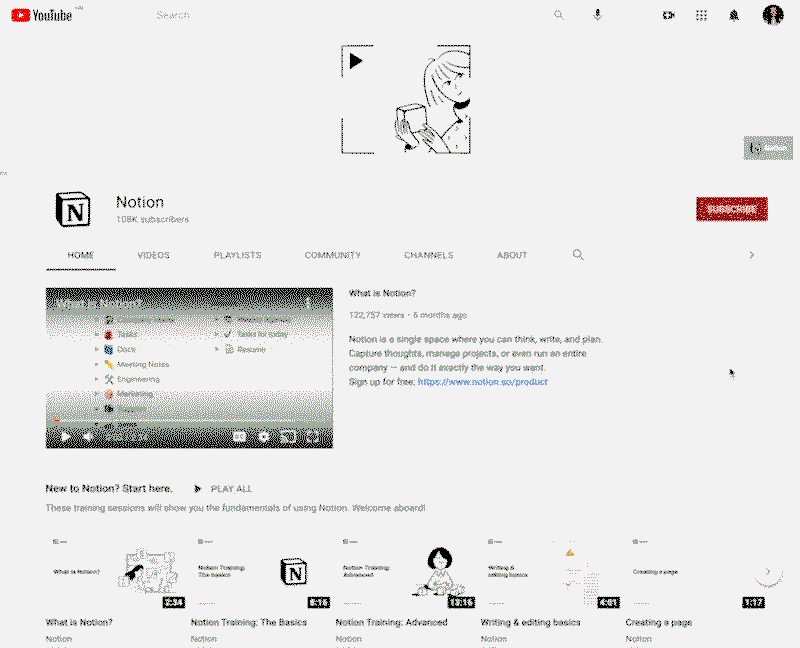
The channel page is broken down into various use cases and types of videos, including:
- Channel video: What is Notion?
- New to Notion? Start here.
- Tutorials: Build something from scratch
- Spotted on YouTube (videos about Notion from other users)
- Tutorials: Essential Notion features
- Tutorials: Tips & tricks for a more efficient workflow
- Tutorials: Using Notion with your team
- Notion around the world (videos about Notion from other users in non-English languages)
- Webinars: Office Hours with Marie Poulin
- Customer stories: See how companies like Figma and Loom use Notion
- Pioneers: Conversations with the minds that shaped computing
It looks like Notion did a great job understanding who their target customers are and what they want to know when starting their research vs. when they’re advanced Notion users.
Notion as a product is the core of these videos, but in many different ways and by focusing on different types of viewers (personal users, solopreneurs, teams).
Titles of these videos are straightforward and reflect the exact words and phrases Notion’s audience uses—it’s no surprise many of them boast tens and hundreds of thousands of views.
4. Publish a free report with original data
Sharing your unique, original data is one of the best ways to infuse your brand into the value you’re giving your audience.
An example comes from Moosend, an email marketing software, who dug into their usage data and shared original cart abandonment email statistics. It’s a great way to kick off a topic with unique insights and continue by providing actionable tips and takeaways.
Usage data is perfect for software companies, but you can collect original insights through surveys and interviews.
Here are a few more examples to inspire you:
- GetResponse’s email marketing benchmark report (analysis of 5.5 billion messages sent by GetResponse customers between July 2019 and June 2020)
- CoSchedule’s marketing statistics (survey with 3,500+ email subscribers and social media followers)
- Orbit Media’s Annual Blogging Survey (survey with 1,000+ bloggers)
You can make your report available for everyone, gate it behind email signup, or publish partial data and limit the rest to those who subscribe. The examples I listed cover all three options.
5. Host webinars
Webinars can have a massive impact on your audience. Their strength is in their versatility, as your webinars can focus on:
- How-to, step-by-step tutorials
- Trends and deep dives on a current topic
- Customer onboarding
- Product walkthroughs and success stories
In other words, you can tailor your webinars to every funnel stage and repurpose its content through other formats and channels in that stage, too.
Folks at Zoho run a library of on-demand webinars on CRM and sales leadership, as well as recurring live weekly webinars:
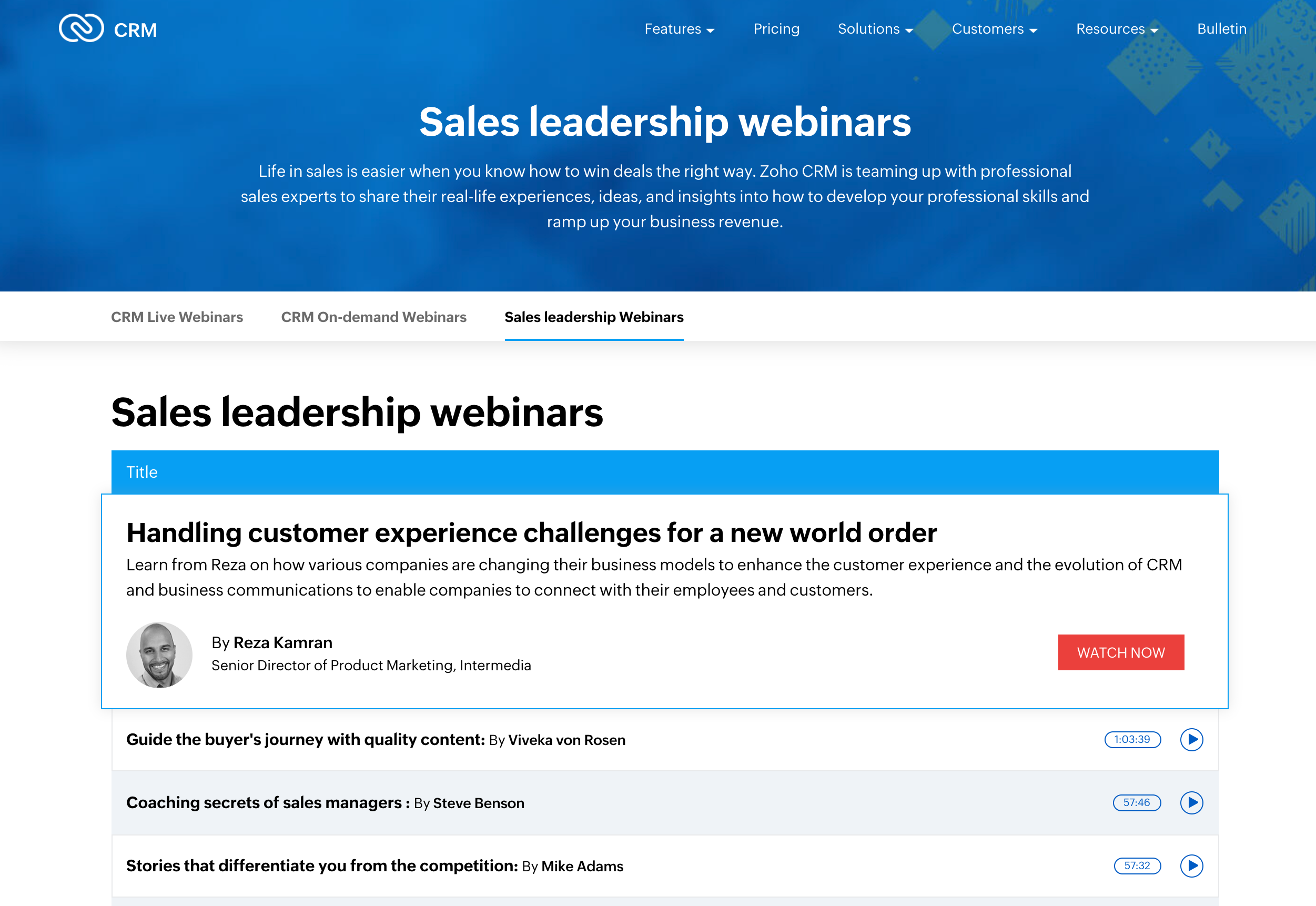
Other webinar examples include HBR’s Global Supply Chains in a Post-Pandemic World and Marketo's Secrets to Automating Campaigns.
The key element of successful webinars is their promotion and your follow-up emails for attendees. Be sure to email your registrants with webinar details, and send them a reminder closer to the start of the webinar.
Then, after the webinar is over, you can follow up with a recording and to ask for feedback. Your attendees will appreciate the opportunity to share their thoughts with you. Use email marketing examples and templates to make this even easier.
6. Collect, share, and regularly update customer reviews and testimonials
Customer reviews are often an afterthought; if someone leaves a review, great, but if not, no sweat.
But reviews are powerful: reports show most customers read reviews before buying, they often treat them like personal recommendations, and companies with recent reviews generate more revenue.
By nudging your happy customers to leave reviews, you can turn their praise into high-impact marketing assets.
Take it from Rent the Runway, a premier fashion subscription service, which allows you to rent designer clothing for a fraction of the price. When you see it for the first time, it sounds too good to be true, right?
They probably know it does, because ‘rent the runway reviews’ is a popular search on Google. Their Rent the Runway reviews page ranks first and features more than 800,000 reviews. These reviews are detailed and include garment size, fit, usual size the customer wears, the occasion clothes were rented for, body measurements, and more.
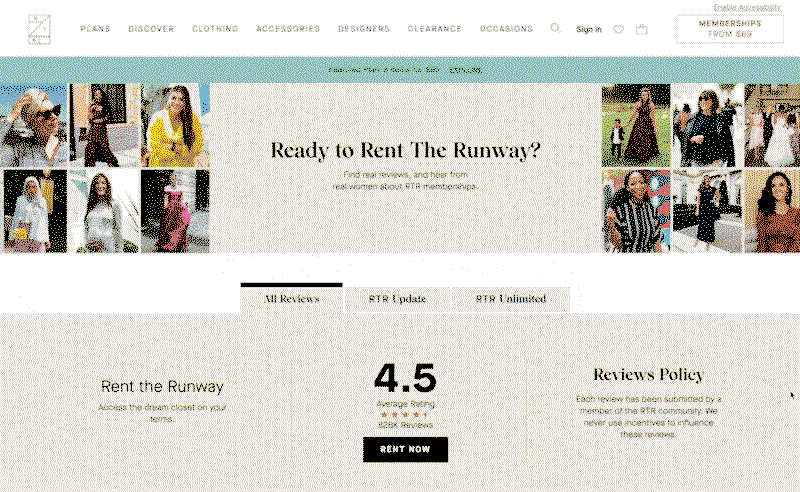
Just what someone new to the RTR world needs if they’re skeptical.
Another great example of using testimonials in marketing is Wise (formerly Transferwise), an online money transfer service, and particularly their Instagram page.
They regularly turn tweets from happy customers into Instagram posts:
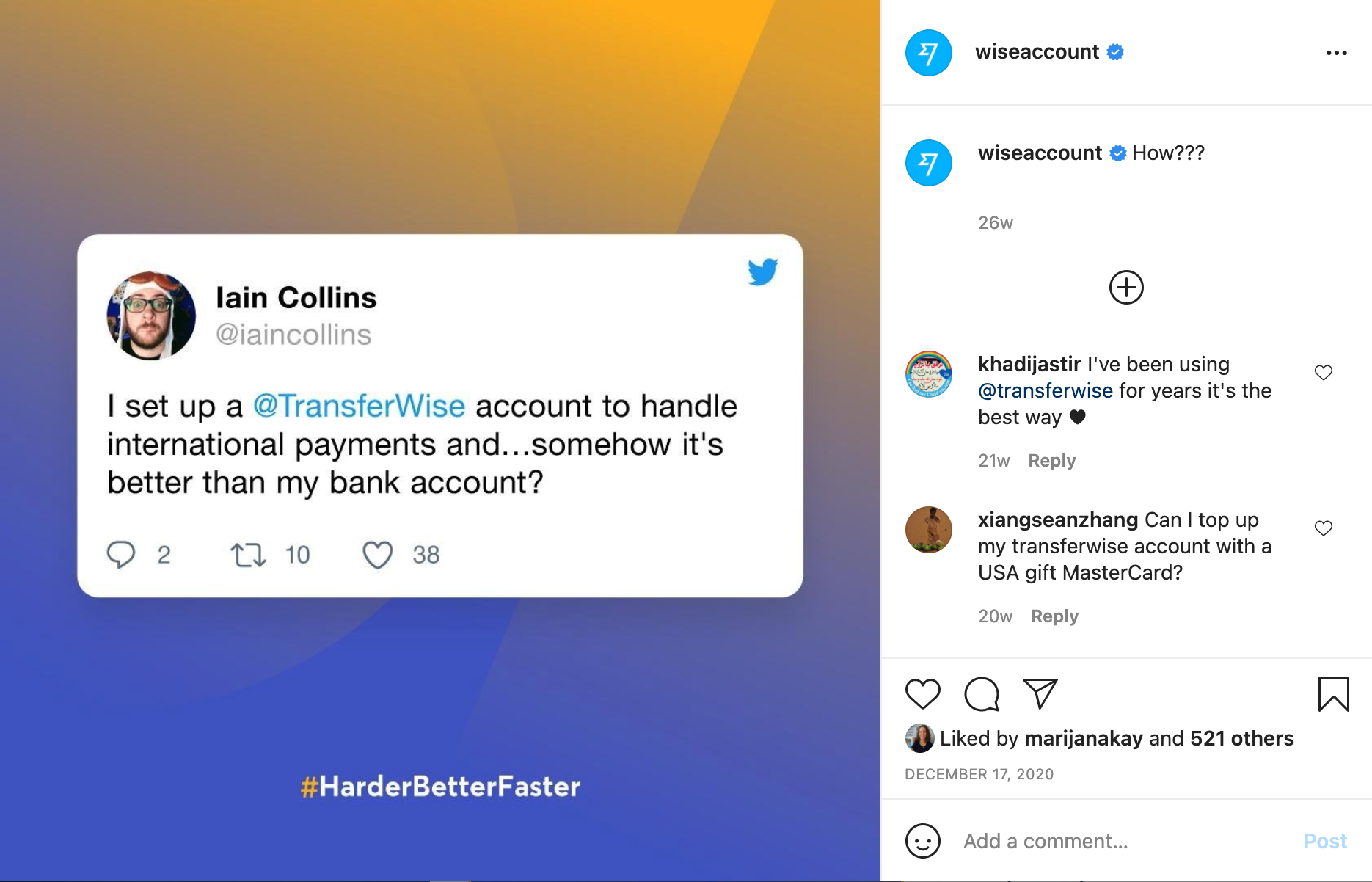
Keep in mind this is a business in a highly regulated financial industry, but they’re not letting that stop them from being honest, funny, cheeky—and from putting their customers first. This is just one of the ways they do it.
Customer testimonials are effective, and they shouldn’t be tucked away somewhere at the bottom of your product pages.
Follow these examples to turn them into demand-generating machines. Add them to your social media calendar, use them in your email campaigns, and build SEO-friendly website assets around them.
7. Leverage partner marketing
Partner marketing helps you compound your inbound marketing and demand gen efforts with those of another brand.
If there’s a company that serves a similar audience to yours, but doesn’t compete with you with their product or features, they’re potentially a great partner.
You can partner on a time-bound piece of content like a webinar or a holiday guide, conduct original research together, guest on each others’ YouTube channels, and more. Opportunities are endless—all that matters is that your partnership makes sense for everyone’s marketing KPIs.
An excellent example of partner marketing comes from Adobe’s Magento and its nine partners (including PayPal, Happy Returns, and DHL among others).
These partners contributed to Magento’s The Journey of a Gift, a holiday guide for ecommerce operators:
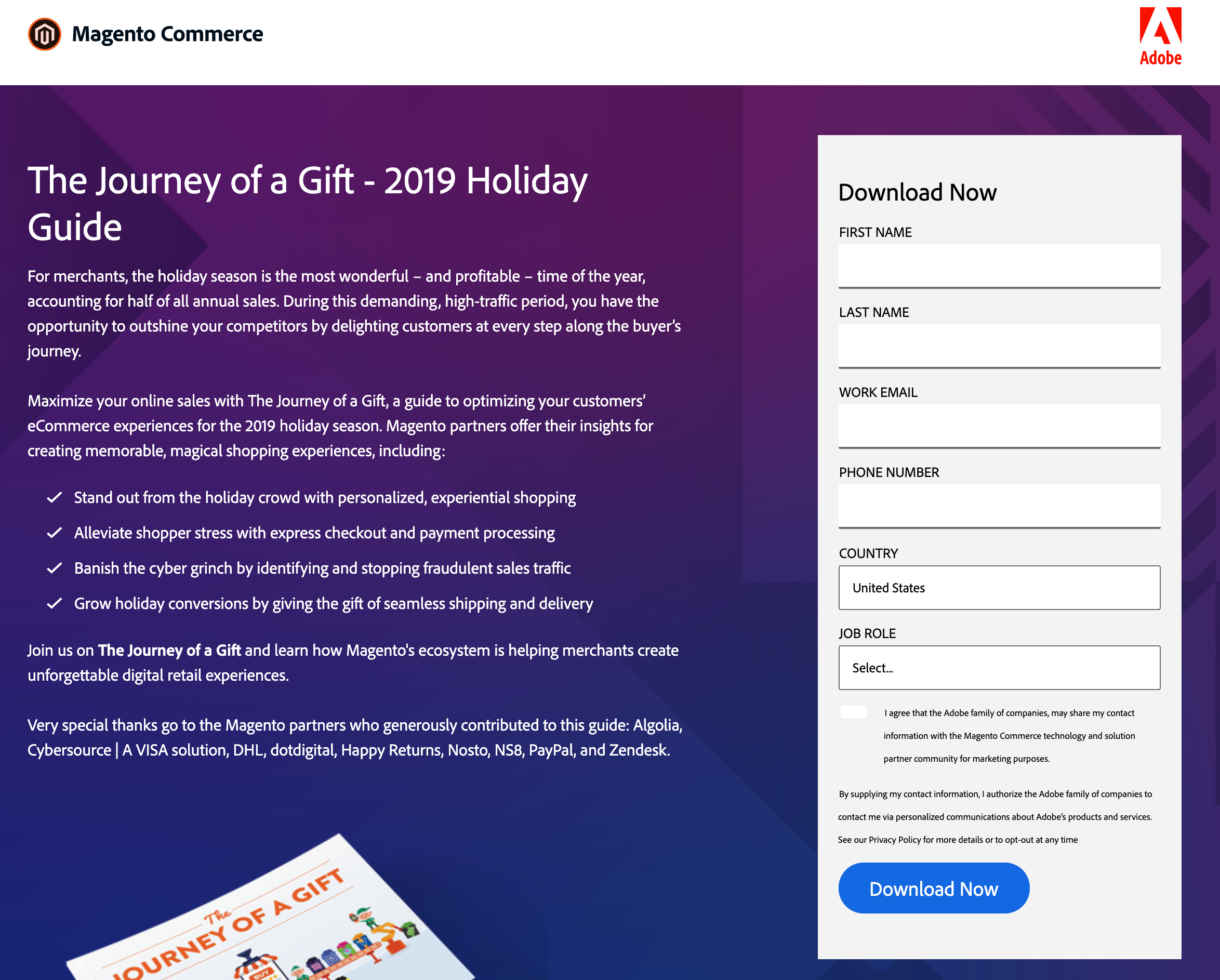
The campaign included a landing page, infographics, webinar presentations, social media content, and emails. When the ebook was finished, each partner received a custom copy and their own promo material to generate leads for their business—a win for everyone.
Bonus: Create a free quiz or assessment tool
We’ve discussed the power of written content and video content, but many brands miss out on the opportunity to include interactive content like a free quiz or assessment on their websites.
According to Single Grain, not only does interactive content increase conversions by 40-50%, people who take quizzes or assessments are 28% more likely to share these assets across social media. This content is an ingenious way to capture attention and drive demand. It’s inbound marketing without feeling like it’s inbound marketing.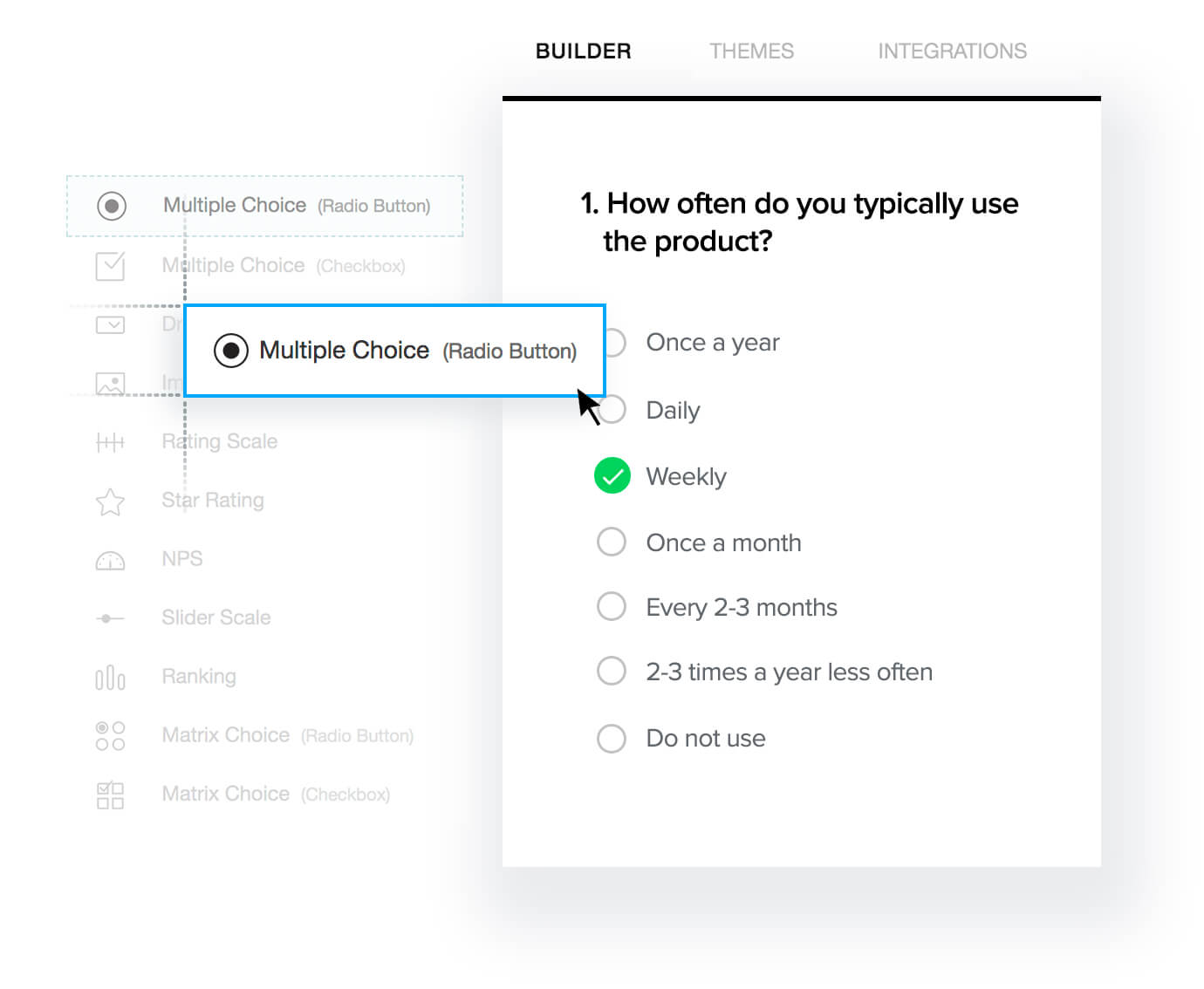
Source: Example of a quiz builder, Zoho
Leave your customers and prospects with a lasting impression by using interactive content like quizzes, assessments, and other creative tools.
Level up your demand generation today
Now you know what it takes to build content that connects your marketing efforts with revenue. It’s time to take action. Pick an example that inspires you the most, get your team together, and brainstorm ideas that match your business and your audience.
Remember: demand generation isn’t a one-off project, but an ongoing effort that pays massive dividends when done well—so start with one technique and do it well.
 Ashwin
AshwinMarketer by day and writer/poet by night! I get the dopamine rush when my thoughts are put down as words or poems. A person with big time OCD (Obsessive Cinema Disorder).
